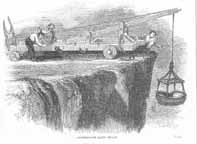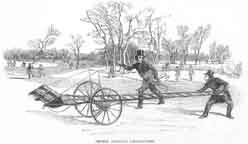Apparently the fact that the entire British coastline was deemed highly dangerous to shipping in the early 1840s had come to the attention of the Royal Humane Society, a committee of Lloyd's Insurance, and a select committee of the House of Commons:
We trust that Christian France will not hesitate to follow, as a primary duty, so generous an example. To stimulate their charity, as well as to inform our friends on this interesting topic, we have on former occasions given several views of our Channel lighthouses and beacons, and have now to present them with engravings of the more important apparatus used on the coast for rescuing drowning persons. [p. 124]
In addition to a simple "Life Buoy" that might be thrown to a swimmer, either from the deck of a ship or from a lifeboat, or yet again from the shore, The Illustrated London News for the week ending 25 February 1842 presented its readers with three life-saving innovations recently introduced. The plate entitled "Captain Manby's Mortar Life-line" (top of page) shows a party of coast-guard actually preparing to fire the mortar which forms a significant part of the apparatus:
The line on reaching the vessel [in distress] usually coils round some of the spars or rigging, or otherwise fastens itself by entanglement, and thus, fixed, opens a ready and under most circumstances, safe communication with the shore. . . . .Captain Manvy's contrivance was modified some years since by Mr. Dennett of New Village, Isle of Wight, by the use of a rocket for the projection of a line, but the mortar practice is more generally adopted.

Our second engraving exhibits the cliff crane invented by J. Johnston [sic], Esq., of Brighton. The preservation of life by this machine is said to have been very great. On the cliffy iron-bound coasts small vessels are often stranded on the beach, to which access is either difficult or impossible, but the cliff crane makes the "way of escape" however steep or rugged the cliff, easy and manageable by a few hands. . . . .
A third contrivance is one of those simple pieces of apparatus which seem in themselves to promise little service, but which, in the hour peril, are oftentimes of greater use than more complex and imposing machines. We allude to the life-buoy supplied by the Humane Society to the boats' crews of fishing and small trading vessels. . . . .

We conclude this notice with a picture of an ice-ladder, which the Royal Humane Society have recently presented to Prince Albert, to be used at the royal skating parties on Virginia Water.
How much conveniently might Elfride, the female protagonist of Hardy's A Pair of Blue Eyes been able to safe Knight from the perilous "Cliff-without-a-Name" had she been able to avail herself of such a life-saving device as Johnstone's [sic] Cliff Crane!
References
"British Life Contrivances for Saving Shipwrecked and Drowning Persons." The Illustrated London News (1842: 124.
Last modified 21 September 2006